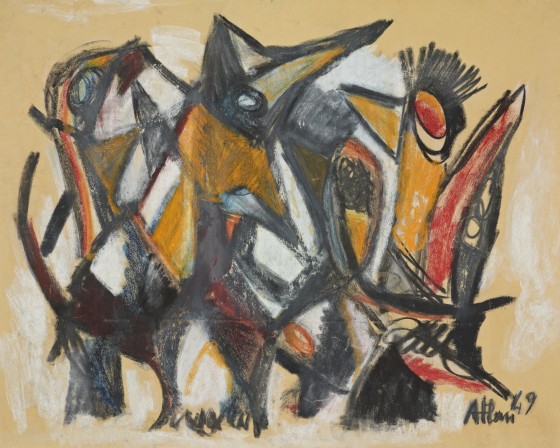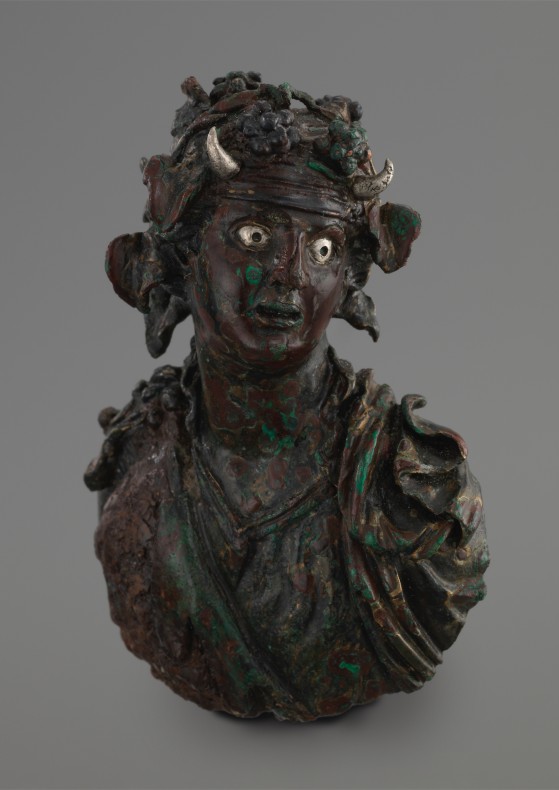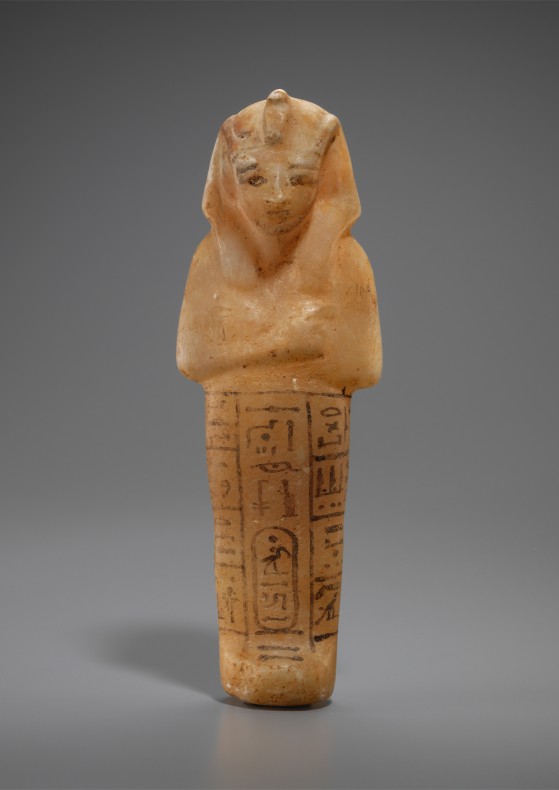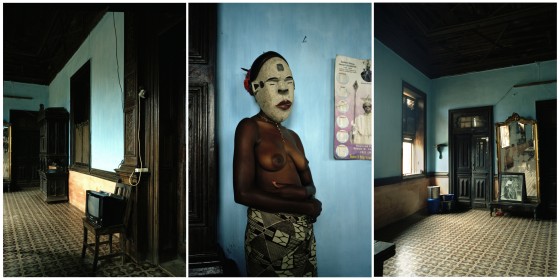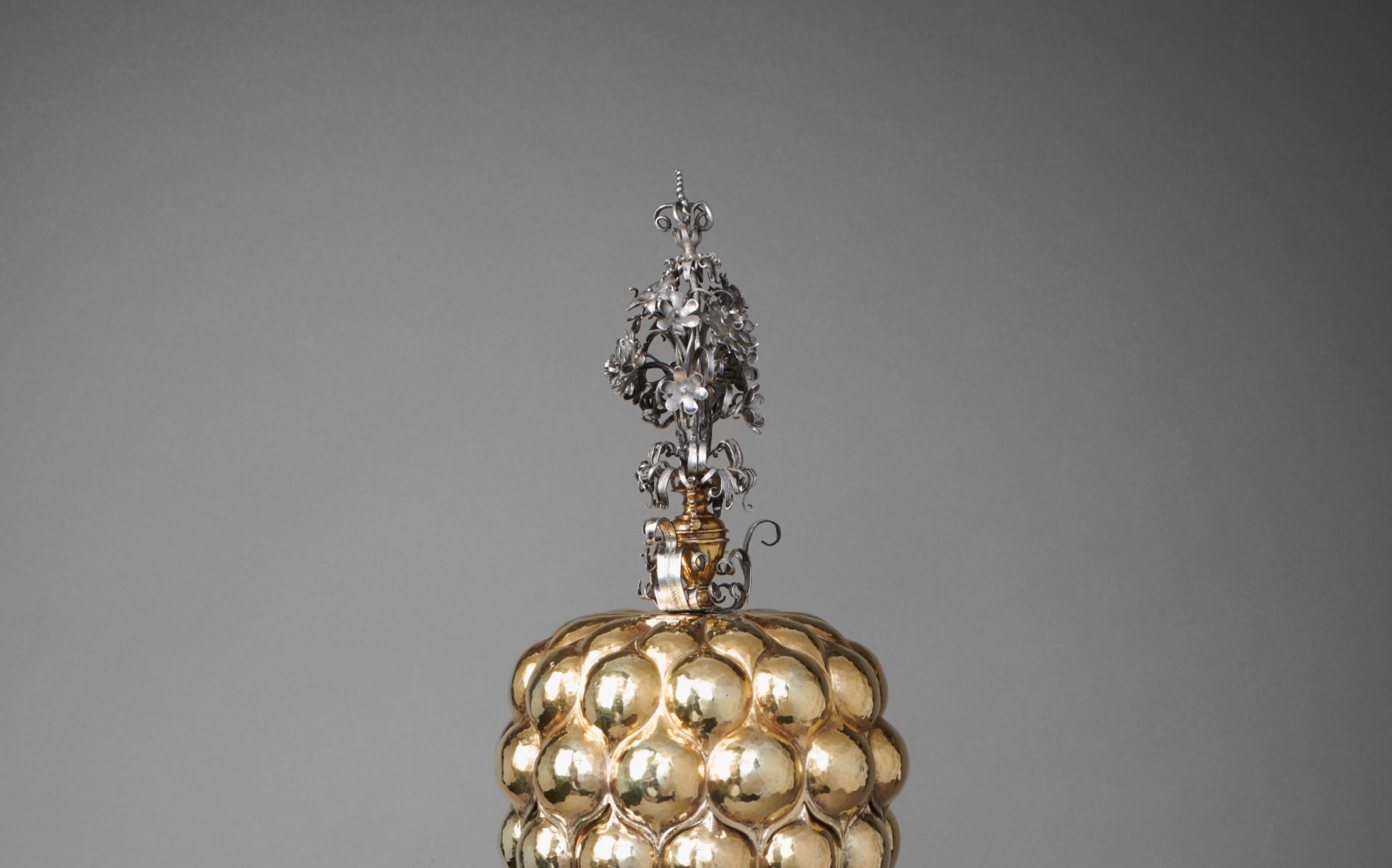
October 2020 Decorative Arts
A Traubenpokal from Nuremberg
With its cup in the form of a bunch of grapes, emerging from the basket that a small-sized winegrower carries on his back, and surmounted at the top by a floral decoration, this partially gilded silver hanap [goblet] is an emblematic object, typical of the production of Nuremberg’s goldsmiths in the early 17th century.
See the artwork in the collectionHans Weber (active 1588-1634)
Traubenpokal (Hanap [goblet] in the form of a bunch of grapes)
Circa 1609-1629
Nuremberg
Partially gilded silver
57 x 13.5 cm
City punch: “N” for Nuremberg (1609-1629)
Master’s punch: weaver’s shuttle in an arched frame
FGA-AD-OBJ-0099
Provenance
Private collection, France, 1980s onward
Lempertz, Cologne, 15 November 2019, lot no. 304
![Hans Weber <br> <em>Traubenpokal (Hanap [goblet] in the form of a bunch of grapes) </em> <br>Circa 1609-1629](/phpThumb/phpThumb.php?src=/users_uploads/oeuvre_oeuvre_gallery_full/5f71a0500b5e5.jpg&sx=0&sy=0&sw=2000&sh=3000&w=1680&q=90&aoe=1)
Nuremberg, capital of silver and goldsmithery in the late Renaissance
Due to its geographical position at the crossroads of the trade routes linking North and South, Nuremberg enjoyed a certain economic prosperity from the Middle Ages onward. During the Renaissance, this city even became one of the most populous, as well as one of Europe’s most important artistic centres, and was home to artists as influential as Dürer.1 A free city within the Holy Roman-Germanic Empire, between 1524 and 1526, Nuremberg was home to the imperial court, whose artistic commissions added to those from the Dukes of Bavaria and the city’s numerous and opulent dynasties of merchants. Drawing on a long tradition of metalworking, silver and goldsmithery was at that time a particularly dynamic branch, before a decline in activity due to the Thirty Years War saw Nuremberg superseded by Augsburg in terms of metal production.
The adoption of the Lutheran religion put an end to commissions by the Catholic Church and by 1525, Nuremberg was producing work for an increasingly civilian population, combining Gothic heritage and Italianate innovation. This fusion gave rise to a unique exuberance of forms, as evidenced by the FGA hanap, with its lobed cup and ornaments drawing upon different repertoires. In connection with this rise, the figure of the goldsmith gained a new status at this time, accumulating the prestige associated with the economic value of the materials worked and the intellectual aura of the artist, in the manner of Wenzel Jamnitzer, the Nuremberg equivalent of the Florentine Benvenuto Cellini. In practice however, rather than a technician, more often than not, the goldsmith was a coordinator.2 A privileged interlocutor of the patron of the commissioned work, he was responsible for overseeing a network of designers, painters, engravers and sculptors whose combined talents gave birth to pieces with complex and sometimes spectacular architectural designs, while playing on the reinterpretation and variation of models, in two or three dimensions.
While engravings were generally used on the ornaments on the surface of objects, the elements in the round made use of wax models, sometimes also intended for casting. This is the case with the winegrower featured on the FGA hanap: we see a merchant balancing on his back the cup in the shape of a bunch of grapes (ill. 2). Made from a silver cast, this model was especially successful and popular.
![Hans WEBER <br> <em>Traubenpokal (Hanap [goblet] in the form of a bunch of grapes) </em> <br>Circa 1609-1629](/phpThumb/phpThumb.php?src=/users_uploads/oeuvre_oeuvre_gallery_full/5f71a248276ae.jpg&sx=0&sy=0&sw=2000&sh=3000&w=560&q=90&aoe=1)
![Hans WEBER <br> <em>Traubenpokal (Hanap [goblet] in the form of a bunch of grapes) </em> <br>Circa 1609-1629](/phpThumb/phpThumb.php?src=/users_uploads/oeuvre_oeuvre_gallery_full/5f71a2e25b1ca.jpg&sx=0&sy=0&sw=1999&sh=2998&w=560&q=90&aoe=1)
The Traubenpokal, from Dürer to Weber
The FGA hanap consists of a gilded silver cup, itself made up of five rows of cupules of increasing dimensions, embossed and chiselled, and of a lid, comprising three identical rows of cupules in decreasing dimensions, that fits into the top of the cup. The foot is decorated with a double row of six cupules. This hanap follows in the wake of Dürer's contemporary lobed cups (Bückelpokale).3 Participating in a form of Gothic revival, the gadroons decorating the surface of these cups evoke, both in their structure and the play of increasing and decreasing motifs, the architecture of ribbed vaults (ill. 3).
The picturesque repertoire inspired by nature and everyday life may be seen in the motif of the winegrower bent under the weight of his basket, and in the bouquet of flowers crowning the lid (ill. 4). It may also be seen in the cup itself whose shape reproduces in a somewhat stylized fashion, the structure of a bunch of grapes, the grapes represented by the bosses. In this sense, this Traubenpokal (meaning literally a cup in the shape of a bunch of grapes) belongs to the same universe as the Birnenpokale (pear-shaped cups), another eminently typical form of German goldsmithery, as well as cups in the shape of a beehive or columbine, all references to the plant and animal world.
![Hans WEBER <br> <em>Traubenpokal (Hanap [goblet] in the form of a bunch of grapes) </em> <br>Circa 1609-1629](/phpThumb/phpThumb.php?src=/users_uploads/oeuvre_oeuvre_gallery_full/5f71a3b7d77eb.jpg&sx=0&sy=0&sw=2000&sh=3000&w=560&q=90&aoe=1)
![Hans WEBER <br> <em>Traubenpokal (Hanap [goblet] in the form of a bunch of grapes) </em> <br>Circa 1609-1629](/phpThumb/phpThumb.php?src=/users_uploads/oeuvre_oeuvre_gallery_full/5f71a5173b014.jpg&sx=0&sy=0&sw=3000&sh=1999&w=560&q=90&aoe=1)
The execution of this type of hanap reflects a mastery of the repoussé technique, which reached its peak in Nuremberg circa 1600, notably under the hammer of Hans Pezolt (1551-1633), whose brilliant association with Christoph Jamnitzer—grandson of Wenzel—ensured the prestige of local gold and silversmiths at the turn of the 17th century. Pezolt, who received the title of master goldsmith in 1578, is renowned for having developed, between 1577 and 1589, the oldest known Traubenpokal. He made one of the most impressive examples of these around 1592-1594, a model that is now preserved at the Kunstgewerbemuseum in Berlin.4
However, it was Hans Weber,5 creator of the FGA cup, who played a role in ensuring the success of this type of hanap in the shape of a bunch of grapes between 1609 and 1629. Several copies bearing his punch, in the shape of a weaver’s shuttle in an arched frame (ill. 5), are present in various public collections.
One, coming from the former collection of Alexandre-Charles Sauvageot (1781-1860), entered the Decorative Arts Department of the Louvre in the late 1820s (inv. OA 628); another is now kept at the Musée de la Chartreuse in Douai (inv. A-1498).6 If the construction of the cup always obeys the same principle—namely a succession of rows of layered gadroons, of increasing or decreasing size—the shape of the foot, making use of various techniques of cast or cut and welded silver, contributes to making each hanap a unique object thanks to the typically unusual association of elements occasionally resulting from serial models. Their use reflects the extent of the creativity of Nuremberg’s goldsmiths after 1600, which, unlike the previous century, was based more on combination and composition than on the invention of deliberately new forms.
Symbolism and use
Deliberately spectacular in appearance, the FGA Traubenpokal, like its cousins—Birnenpokale and Bückelpokale—participated in the life of the Germanic courts, in both their ceremonial and festive dimensions. Intended to occupy a prominent position on buffets and dressers during banquets, it reflects the ostentatious dimension of late Renaissance tableware. The effects resulting from the use of the repoussé technique contribute to the fascination exerted by these cups in the shape of a bunch of grapes. On each protuberance, the multitude of tiny marks left by the imprint of the goldsmith’s hammer mirror and reflect the surrounding space, accentuating, at dusk, the potentially phantasmagorical effect of the flickering glow of flames.
This ostentatious aspect does not, however, exclude the traditional vocation of the object, both symbolic and real. The FGA hanap is an example of Willkommenpokale, a welcome drink proffered to guests at princely courts, a custom connected to an “archaic practice according to which the guest and host implicitly claimed to be gathered with peaceful intentions.”7 More broadly, with its shape and decor inspired by the world of vines, it refers to the central place occupied by wine in Germanic society in the 16th and early 17th century, ranging from moderate and codified consumption to veritable drinking sprees, on the part of monarchs and their courtiers. Drinking games gave rise to the creation of all kinds of glasses, vidrecomes, cups and utensils, both remarkable and amusing, ranging from extraordinary nefs to so-called fool’s glasses (Sturzbecher), stemless glasses from which people drank at the same time in a single draught, often in a toast to the future spouses during wedding celebrations.
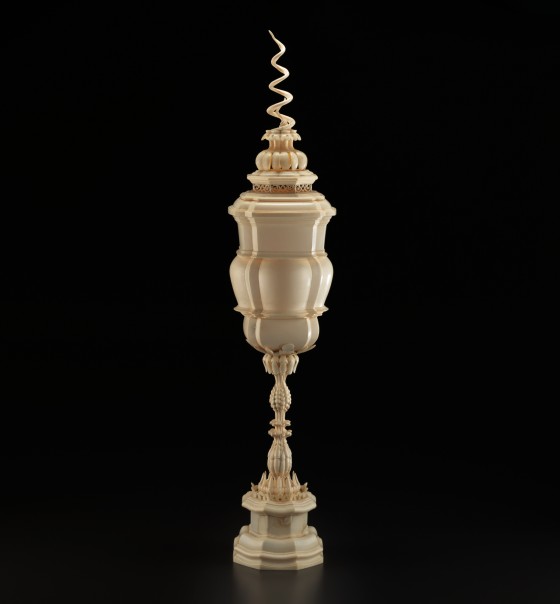
Finally, with its strange form, its demonstration of skill and verticality, the Traubenpokal is fully in line with the culture of Kunst- und Wunderkammer developed in parallel by the Germanic courts. It is similar, in this regard, to the ivory feats of skill realized by the princes and their master turners, from the end of the Renaissance to the 18th century, of which the FGA also boasts some impressive examples. (ill. 6).
Dr Fabienne Fravalo
Curator Decorative Arts Collection
Geneva, June 2020
Notes and references
- See J. Chipps Smith, Nuremberg, a Renaissance city; R. Kahsnitz and W. D. Wixom (ed.), Gothic and Renaissance Art in Nuremberg, 1300-1550.
- See L. Seelig, “L’orfèvrerie et les arts plastiques à l’époque de la Renaissance allemande” in Trésors de l’orfèvrerie allemande du XVIe siècle, p. 49-65.
- M. Bimbenet-Privat and J. Kugel, Chefs-d’œuvre d’orfèvrerie allemande, p. 77-78.
- K. Tebbe, Nürnberger Goldschmiedekunst, 1541-1868, vol. 2: Goldglanz und Silberstrahl, p. 179-182.
- K. Tebbe, Nürnberger Goldschmiedekunst, 1541-1868, vol. 1: Meister, Werke, Marken, p, 434, no. 0934.
- M. Bimbenet-Privat and A. Kugel, Chefs-d’œuvre d’orfèvrerie allemande, p. 122-123, cat. no. 21.
- A. Scherner, “’Hier j’étais saoûl’. Alcool et jeux à boire au début de l’époque moderne” in Trésors de l’orfèvrerie allemande du XVIe siècle, p. 45.
Bibliography
Trésors de l’orfèvrerie allemande du XVIe siècle, Collection Rudolf-August Oetker, exhibition catalogue [Toulouse, Fondation Bemberg, 1 July – 25 September 2016], Toulouse, Fondation Bemberg, 2016
Wenzel Jamnitzer und die Nürnberger Goldschmiedekunst 1500-1700, Goldschmiedearbeiten – Entwürfe, Modelle, Medaillen, Ornamentische, Schmuck, Porträts, exhibition catalogue [Nuremberg, Germanisches Nationalmuseum, 28 June – 15 September 1985], Munich, Klinkhardt & Biermann, 1985
Bimbenet-Privat, Michèle, and Kugel, Alexis, Chefs-d’œuvre d’orfèvrerie allemande, Renaissance et baroque, Dijon, Faton, 2017
Kahsnitz, Rainer and Wixom, William D. (ed.), Gothic and Renaissance Art in Nuremberg, 1300-1550, exhibition catalogue [New York, The Metropolitan Museum of Art, 8 April – 22 June 1986; Nuremberg. Germanisches Nationalmuseum, 24 July – 28 September 1986], Munich, Prestel-Verlag, 1986
Maué, Hermann, et al., Quasi centrum Europae, Europa kauft in Nürnberg, 1400-1800, exhibition catalogue [Nuremberg, Germanisches Nationalmuseum, 20 June – 6 October 2002], Nuremberg, Verlag des Germanischen Nationalmuseums, 2002
Smith, Jeffrey Chipps, Nuremberg, a Renaissance city, 1500-1618, University of Texas Press, 1983
Tebbe Karin, Nürnberger Goldschmiedekunst, 1541-1868, volume 1: Meister, Werke, Marken, volume 2: Goldglanz und Silberstrahl, exhibition catalogue [Nuremberg, Germanisches Nationalmuseum, 20 September 2007 – 13 January 2008], Nuremberg, Verlag des Germanischen Nationalmuseums, 2007

